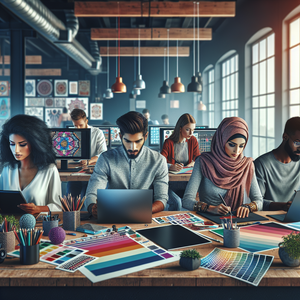
Navigating the Graphic Design Job Market: A Comprehensive Guide to Opportunities
Starting a career in graphic design today is a thrilling yet challenging journey. The path to landing a job in this creative field varies greatly depending on your approach, where you live, and your set of skills. Using platforms like Dribbble, Upwork, and LinkedIn can open up many opportunities, from freelance gigs to full-time positions. Besides these online options, building a strong social media presence, showcasing an impressive personal portfolio, and engaging in local networking are essential steps to landing a job. Experts stress the importance of keeping your portfolio updated and staying active on social media, while others highlight the benefits of freelance websites and local job boards. This reflects the diverse nature of the graphic design world, where strategies should match personal goals and market trends. Some thrive in freelance roles, enjoying flexibility and varied experiences, while others prefer the stability of traditional jobs. Success relies on adaptability, persistence, and effectively using the tools at your disposal. This guide explores various graphic design roles, providing a detailed look at tasks and requirements to offer a clear picture of opportunities in this lively industry.
Job Summaries:
Freelance Graphic Designer:
- As a freelance graphic designer, you have the freedom to choose projects, whether it's branding or digital content creation.
- This role requires a strong portfolio that highlights your versatility and creativity, proficiency in design tools like Adobe Creative Suite, and excellent communication skills to maintain client relationships.
- Freelancing offers the flexibility to choose clients and work environments, appealing to those who prefer non-traditional employment.
- Websites like Upwork and Fiverr are essential, providing access to global clients and diverse projects.
- Regularly updating your portfolio and using social media effectively is key to attracting clients.
- Successful freelancers often share stories of overcoming challenges like tight deadlines or client revisions, showcasing resilience and adaptability.
In-House Graphic Designer:
- An in-house graphic designer creates visual content that matches a company's brand identity across all platforms.
- Duties include working with marketing teams, creating promotional materials, and ensuring brand consistency.
- Typically, this role requires a degree in graphic design or a related field, along with experience in design tools and the ability to work under tight deadlines.
- In-house positions offer job stability and the chance to gain a deep understanding of a single brand.
- Companies value designers who can easily integrate with their brand culture, making experience with similar brands a significant plus.
- Attending industry events can help with networking and finding in-house opportunities.
Art Director:
- As an art director, you lead the visual aspects of projects, guiding a team to achieve a cohesive look.
- Responsibilities include developing ideas, setting design standards, and ensuring projects meet the client's vision.
- This role requires extensive experience, strong leadership skills, and a keen eye for aesthetics.
- Art directors often work in advertising agencies or media companies, playing a crucial role in major design projects.
- Success depends on a history of project leadership and creative ideas.
- Building a professional network and seeking mentorship from experienced art directors can provide valuable knowledge and career growth opportunities.
- Sharing experiences of leading successful campaigns can offer inspiration to aspiring art directors.
UX/UI Designer:
- UX/UI designers are tasked with creating intuitive and engaging user experiences for digital platforms.
- Their duties include conducting user research, developing wireframes, and working with developers.
- Important skills include a background in design, knowledge of user-focused design principles, and proficiency in tools like Sketch or Figma.
- This role is essential in the tech industry, ensuring products are both functional and user-friendly.
- Keeping up with the latest UX/UI trends and continuously enhancing skills through courses and workshops can improve employability.
- Creating case studies that highlight problem-solving skills and design thinking processes can make your portfolio stand out.
- Including feedback from users or clients can add authenticity to your work.
Brand Identity Designer:
- Specializing in brand identity design involves creating logos, color schemes, and visual elements that represent a brand's personality.
- This role requires creativity, attention to detail, and a strong understanding of branding principles.
- Brand identity designers help businesses establish a unique presence in the market, which is crucial for companies looking to stand out.
- Showcasing successful brand transformations in your portfolio can attract clients looking for fresh perspectives.
- Joining branding communities and forums can provide inspiration and feedback, enhancing your work.
- Sharing stories of how a rebrand positively impacted a client's business can demonstrate the tangible benefits of effective brand identity design.
Motion Graphics Designer:
- Motion graphics designers create animated graphics for videos, ads, and multimedia content.
- Tasks include designing storyboards, animating graphics, and integrating audio elements.
- Proficiency in software like After Effects and Cinema 4D is essential.
- Motion graphics designers enhance visual storytelling, making their skills highly sought after in entertainment and advertising.
- Staying informed about the latest animation techniques and trying new styles can set you apart in this competitive field.
- Collaborating on short films or digital ads with peers can expand your portfolio and showcase your range.
- Sharing behind-the-scenes experiences of complex projects can engage readers and demonstrate your expertise.
Web Designer:
- Web designers are responsible for creating visually appealing and user-friendly websites.
- Duties include designing page layouts, choosing color schemes, and ensuring responsive design across devices.
- A strong understanding of HTML/CSS, experience with design tools, and an eye for detail are necessary.
- Web designers play a crucial role in shaping businesses' online presence, making them indispensable in the digital age.
- Familiarity with SEO principles and web analytics can further enhance your value, making you a more comprehensive contributor to a company's digital strategy.
- Including case studies of successful website launches can illustrate the impact of effective web design.
Visual Designer:
- Visual designers focus on creating compelling graphics for various media, including websites, apps, and ads.
- This role requires a solid understanding of design principles, creativity, and proficiency in graphic design software.
- Visual designers contribute to the overall look and feel of digital products, boosting user engagement and brand recognition.
- Building a diverse portfolio that shows versatility across different media and styles can significantly increase your appeal to potential employers.
- Sharing personal stories of creative breakthroughs can add a human touch to your professional journey.
Packaging Designer:
- Packaging designers create visual designs for product packaging, balancing aesthetic appeal with functionality.
- Responsibilities include brainstorming design concepts, creating mockups, and collaborating with product teams.
- A degree in graphic design, creativity, and knowledge of packaging materials are important.
- Packaging designers play a key role in product marketing, attracting consumers and communicating brand values.
- Understanding production processes and sustainability considerations can give you a competitive edge, as brands increasingly focus on eco-friendly packaging solutions.
- Showcasing creative packaging designs that led to increased sales can demonstrate the effectiveness of your work.
Digital Illustrator:
- Digital illustrators produce custom illustrations for books, ads, and other media.
- Tasks involve developing concepts, creating sketches, and finalizing artwork using digital tools.
- Strong artistic skills, creativity, and proficiency in illustration software are essential.
- Digital illustrators bring stories to life through their artwork, making them valuable in publishing, advertising, and entertainment industries.
- Building a strong online presence through platforms like Behance or Instagram can attract clients and collaborations, showcasing your unique style and artistic vision.
- Sharing the inspiration behind your illustrations can engage readers and offer a glimpse into your creative process.
Finding your way in the graphic design job market requires a mix of creativity, technical skills, and strategic networking. By understanding the different roles and making the most of available resources, you can discover opportunities that align with your career goals. Keep improving your skills, stay informed about industry trends, and continually update your portfolio to succeed in this ever-changing field. Engaging with the community, sharing experiences, and staying flexible will help you carve out a successful path in graphic design. Whether through personal stories or industry knowledge, this journey is best shared and experienced together.
Explore More Jobs
